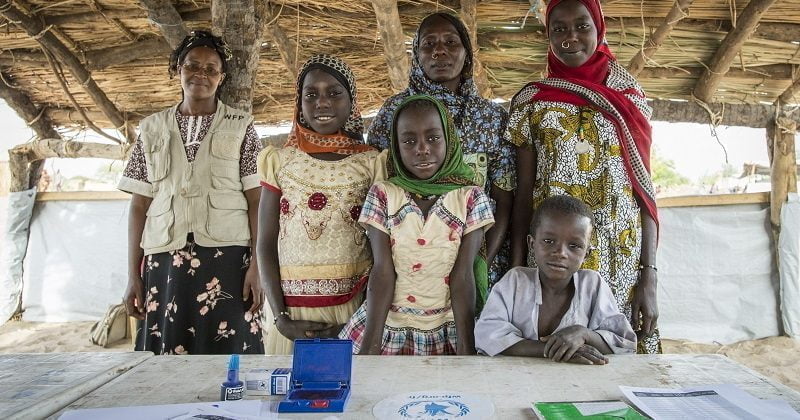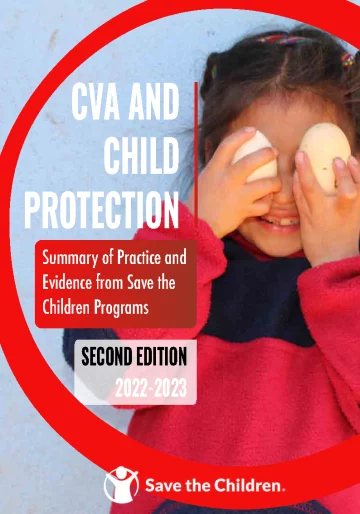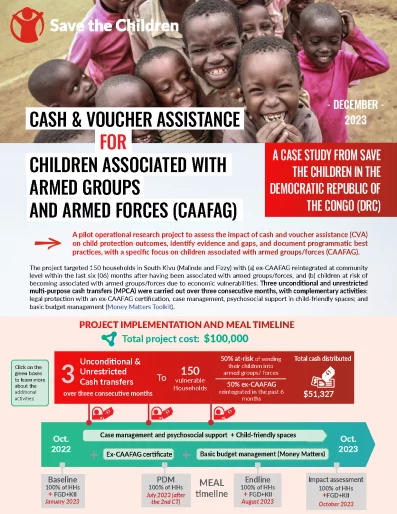Protection and Cash and Voucher Assistance
How can Cash and Voucher Assistance (CVA) support protection outcomes? Please find a brief summary below, and for the very latest information, refer to the Global Protection Cluster Task Team on Cash for Protection.
The Protection Sector is concerned with the safety, dignity and rights of people affected by disaster or armed conflict and comprises four areas of responsibility – Child Protection, Gender-Based Violence, Mine Action, and Housing, Land and Property. Protection activities may involve preventive actions that aim to stop, prevent or alleviate the worst effects of abuses, remedial actions to help people recover, and environment-building actions to create or consolidate an environment conducive to full respect for the rights of individuals and groups.
CVA is used to address a range of household and individual protection needs. This includes cash assistance for basic needs for persons with special requirements and acute vulnerabilities, single parents with multiple dependents, unaccompanied minors, persons with disabilities, survivors of violence and other categories of people deemed at heightened protection risk. CVA might also be used as part of a sexual and gender based violence (SGBV) prevention and response, and to support displaced people by assisting voluntary return.
 For further information and resources, visit the GPC Task Team on Cash for Protection page on the Global Protection Cluster website.
For further information and resources, visit the GPC Task Team on Cash for Protection page on the Global Protection Cluster website.

Related content

Colombia and Lebanon Evaluation Report: Measuring the impact of cash on child protection outcomes
Report
As humanitarian crises break down traditional protection mechanisms and the loss of income restricts access to basic resources, children become increasingly vulnerable to abuse, neglect, exploitation, and violence. Cash and Voucher Assistance (CVA) is a critical modality that is increasingly being adopted to support the prevention and response to child protection (CP) risks. While the evidence...

Cash & Voucher Assistance (CVA) & Child Protection (CP) Global Study – Research Report in the DRC, Egypt, Lithuania and the Philippines
Report
Since 2022, Save the Children has been scaling up its use of CVA for Child Protection (CP) programming through various pilot projects.
Research was commissioned in four countries in 2022-23 to generate evidence and learning to inform the design of future programming but also to design a robust implementation and monitoring methodology to measure the outcomes of CVA on specific child...

Cash and Vouchers Assistance (CVA) and Child Protection: Summary of practice and evidence from Save the Children programmes 2023 Edition
Report
In an effort to increase global knowledge and learning, Save the Children conducted a global review of twenty Country Offices and their programs in order to assess and highlight the impact that different forms of Cash and Vouchers Assistance (CVA) have on Child Protection (CP) outcomes, to identify evidence gaps and document best programmatic practices.
This follows and uses the same...

Cash and Voucher Assistance (CVA) for Children Associated with Armed Groups and Armed Forces (CAAFAG): A case study from Save the Children in the Democratic Republic of the Congo (DRC)
Case Study
This case study is drawn from Save the Children CVA operations in the DRC (South Kivu) in 2022 and 2023, focusing on children associated with armed groups/forces (CAAFAG).
Following an overview of the context, it deep dives into the technical design of the CVA response and continues with a presentation of the main findings on basic need coverages and coping strategies as well as on child...

Cash and Voucher Assistance (CVA) for Children Associated with Armed Groups and Armed Forces (CAAFAG): Program Summary and Evidence-Building Infographic: A case study from Save the Children in the Democratic Republic of the Congo (DRC)
Case Study
This infographic gathers key programmatic data from Save the Children CVA operations in the DRC (South Kivu) between October 2022 and October 2023, which aimed to assess and highlight the impact that CVA has on child protection outcomes, with a specific focus on children associated with armed groups/forces (CAAFAG).
Starting with an overview of the program and key take-aways, it continues...

Leveraging Cash Assistance in GBV Case Management as a Tool in Moldova’s Ukrainian Refugee Response
Case Study
In 2023, as part of the Ukrainian refugee response in Moldova, the United Nations Population Fund (UNFPA) conducted a pilot to integrate cash assistance into gender-based violence (GBV) case management. Targeting GBV survivors and those at risk, including Ukrainian refugees and vulnerable Moldovans, the program aimed to mitigate GBV risks and enhance GBV response by addressing economic...

Exploration des liens entre transferts monétaires et protection sociale en Afrique de l’Ouest et du Centre
Enregistrement webinaire
Ceci est le premier d’une série des webinaires visant à analyser les liens entre les transferts monétaires humanitaires et la protection sociale dans la région de l’Afrique de l’Ouest et du Centre. Le webinaire a tenté de poser un cadre de réflexion sur cette thématique grâce à l’ouverture de Dr. Sintike Tarfa Ugbe, Directrice des Affaires Humanitaires et Sociales de la...

Locally Led Anticipatory Action Guide and Toolkit
Guidelines and Tools
How civil society organisations can engage with communities, and collaborate with mandated, technical and donor agencies to localise and scale up early warning and early action
The purpose of the guide is to support civil society organisations to engage with communities and other actors and structures at the local level; to play a central role in planning and establishing local mechanisms...

Community Insight Survey for Cash-Based Programs in Afghanistan
Case Study
The Community Insight Survey for Cash-Based Programs by iMMAP Inc. in Afghanistan provides critical insights into the effectiveness of cash-based humanitarian assistance in the country. Conducted across diverse regions of Afghanistan, the survey highlights the positive impact of cash assistance on household well-being, while also identifying significant gaps in meeting basic needs,...

Egypt Cash and Voucher Assistance (CVA) and Child Labor: Program Summary and Evidence-Building Infographic
Case Study
This infographic highlights the main findings and achievements of Save the Children CVA operations in Egypt between March 2023 and November 2023, which aimed to assess and highlight the impact that CVA has on child protection outcomes, with a specific focus on unaccompanied and separated refugee children exposed to child labor.
The document then provides an overview of the technical design,...

Philippines Cash and Voucher Assistance (CVA) and Child Early and Forced Marriages and Unions (CEFMU): Program Summary and Evidence-Building Infographic
Case Study
This infographic gathers key programmatic data from Save the Children CVA operations in the Philippines between January and August 2023, which aimed to assess and highlight the impact that CVA has on child protection outcomes, with a specific focus on Child Early and Forced Marriages and Unions (CEFMU).
Starting with an overview of the program, it then presents the main findings on CVA...

Lithuania Cash and Voucher Assistance (CVA) for Child Protection (CP): Program Summary and Evidence-Building Infographic
Case Study
This infographic gathers key programmatic data from Save the Children CVA operations in Lithuania, within the larger context of the Ukrainian crisis, between December 2022 and April 2023, which aimed to assess and highlight the impact that CVA has on child protection outcomes, with a specific focus on child distress and violence in the home.
Starting with an overview of the program, it...


